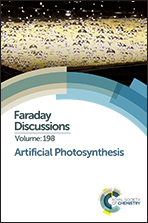Development of a dye molecule-biocatalyst hybrid system with visible-light induced carbon–carbon bond formation from CO2 as a feedstock
Abstract
Recently, CO2 utilization technology, including artificial photosynthesis, has received much attention. In this field, CO2 is used as a feedstock for fuels, polymers and in other chemical processes. Of note are malic enzymes (MEs) which catalyze the reaction of malic acid to pyruvic acid and CO2 with the co-enzyme NADP+, and catalyze the reverse reaction of pyruvic acid and CO2 to malic acid with the co-enzyme NADPH. Thus, MEs are also an attractive biocatalyst for carbon–carbon bond formation from CO2. Studies of the visible light-induced malic acid production from pyruvic acid and CO2 using an electron donor, a photosensitizer, an electron mediator, ferredoxin-NADP+ reductase, NADP+, and ME have been reported. However, modification of these systems is required, as they are very complicated. In this study, the visible light-induced carbon–carbon bond formation from pyruvic acid and CO2 with ME using the photoreduction of 1,1′-diphenyl-4,4′-bipyridinium salt derivatives as a novel electron mediator with water-soluble tetraphenylporphyrin tetrasulfonate (H2TPPS) in the presence of triethanolamine (TEOA) as an electron donor was developed. When a sample solution containing TEOA, H2TPPS, 1,1′-diphenyl-4,4′-bipyridinium salt derivative, pyruvic acid, and ME in CO2-saturated bis–tris buffer was irradiated, the major product was oxaloacetic acid. Thus, a visible light-induced photoredox system for carbon–carbon bond formation from CO2 with ME using 1,1′-diphenyl-4,4′-bipyridinium salt derivative as an electron mediator was developed.
- This article is part of the themed collection: Artificial Photosynthesis

 Please wait while we load your content...
Please wait while we load your content...